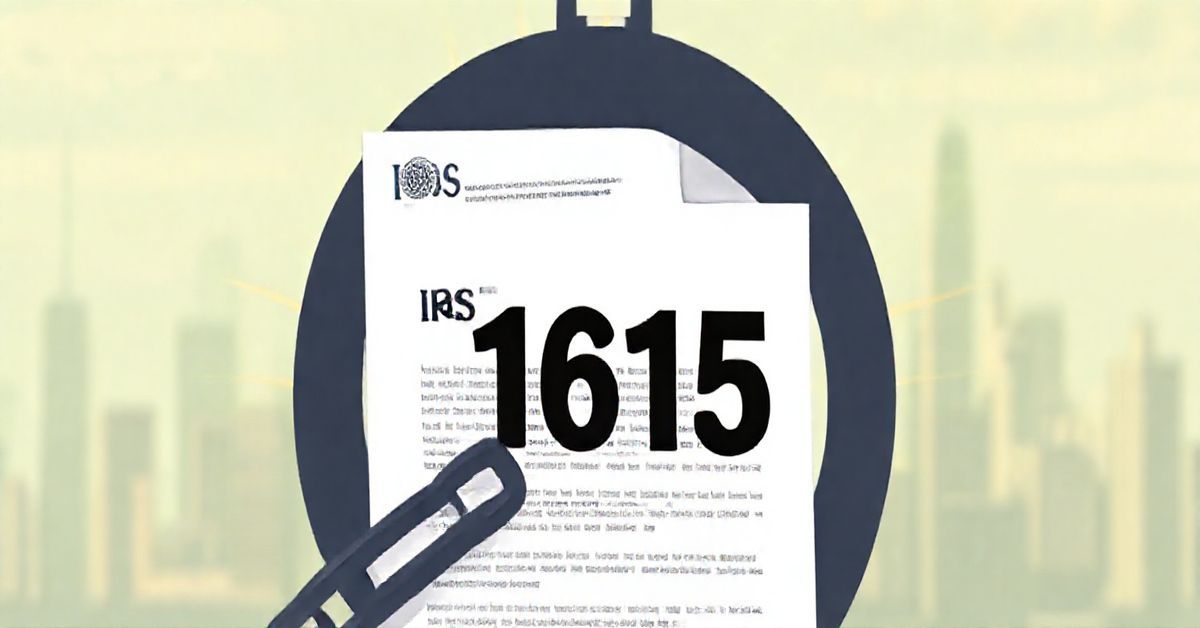Understanding IRS Letter 1615: Your Guide to a Released Tax Lien
Have you ever received an official-looking letter from the IRS and felt a knot of anxiety tighten in your stomach? If you’ve ever dealt with a tax lien, that feeling is probably familiar. But what if that letter is actually good news? That’s where Letter 1615 comes in. It’s a “Notice of Tax Lien Release”, and it signals a positive turn in your tax journey! Let’s break down what this letter means and why it matters.
What’s a Tax Lien, Anyway?
Before we dive into the release, let’s quickly recap what a tax lien is. Think of it as a kind of “placeholder” on your property – like a house, car, or even a bank account. When you owe back taxes to the IRS, and don’t pay them, the IRS can file a federal tax lien against you. This makes it a public record that the IRS has a claim on your assets. It can affect your ability to get loans, sell property, and generally move forward financially. It essentially lets the world know that you owe the IRS money.
Why a Tax Lien is Filed
The IRS doesn’t file a tax lien immediately. Usually, it’s a result of a few things:
- You’ve failed to pay your tax bill after the IRS has sent you multiple notices.
- You didn’t respond to IRS notices requesting payment.
- You haven’t worked out a payment plan or other resolution with the IRS.
If these situations occur and your tax debt remains unpaid, the IRS will move forward with the lien, letting everyone know about this debt.
The Good News: Letter 1615 is Your Green Light
Now, back to Letter 1615. This letter is proof that the IRS has released the tax lien it had previously placed on your assets. It’s the official document that essentially says “we’re done here” in relation to that particular debt. This is great news because it means:
- Your tax debt is resolved: You’ve either fully paid off your debt or the IRS has agreed to remove the lien through some agreement like an Offer in Compromise or partial payment.
- The lien is no longer active: The public record of the tax lien will be updated to show it’s released.
- Your financial freedom is restored: You can now move forward with less of a burden on your credit score and ability to get new loans or sell property.
How to Identify Letter 1615
Letter 1615 isn’t always easy to identify among the other mail from the IRS. Here’s what to look for to make sure you have the right document:
- Official IRS Letterhead: The letter will have the official IRS logo and letterhead at the top.
- Specific Heading: The title will state “Notice of Federal Tax Lien Release.”
- Your Name and Information: The letter will include your name, address, and other relevant information, such as your Social Security number or Taxpayer Identification Number.
- The Specific Tax Debt: The letter will also specifically mention the tax debt the lien is associated with. It will include the tax year(s) and type of tax (income, payroll, etc.).
- File Number: It will usually include a “File Number” that is specific to the released lien.
Why is the Lien Release Important?
A tax lien release is critical for several reasons. It’s not just a piece of paper. Here’s what having a released lien means for you:
- Clear Credit History: Tax liens show up on your credit report and can negatively affect your credit score. A released lien means this negative mark should be removed over time, allowing you to rebuild your credit.
- Financial Transactions: A tax lien can complicate buying or selling property, securing a loan, or opening new lines of credit. With a release, you should no longer face this obstacle.
- Peace of Mind: Dealing with tax problems can be stressful. A released tax lien represents closure and allows you to move on.
What Should You Do When You Receive a Letter 1615?
Once you receive Letter 1615, don’t just file it away! Here’s what you should do:
- Read it Carefully: Make sure the information is accurate. Check your name, Social Security number or Taxpayer Identification Number, the tax year, and type of tax. If there are any discrepancies, contact the IRS immediately.
- Keep it Safe: This is an important document, keep it with your important tax records. You may need it in the future for various financial transactions or if any credit reporting issues arise.
- Verify with County Records: Though the IRS has released their claim, the lien is often a part of local public records, filed at the county level. Check with your county recorder or clerk’s office to confirm the lien is updated there as well. Some jurisdictions will update this automatically, but some may require you to send a copy of the Letter 1615 for them to take action.
- Check Your Credit Report: Review your credit report to ensure the tax lien is reported as “released” or removed. It may take a few months for credit reporting agencies to update. Contact the credit bureaus and provide the IRS release documentation if you see errors. This is important for ensuring that your credit is not negatively affected.
Potential Issues After Receiving Letter 1615
While a Letter 1615 is generally positive, a few potential issues could arise:
- Incorrect Information: Sometimes, the IRS might make mistakes. Verify all the information on the release is correct. Report any errors promptly to the IRS.
- Delayed Credit Reporting: As mentioned before, it can take time for credit reporting agencies to update. Don’t panic if it isn’t immediate but keep an eye on it.
- Local Filing Issues: If you do not verify the lien release with your local county office, it could cause problems. Some jurisdictions may require action from you to record the release.
What If You Don’t Receive a Letter 1615?
If you’ve paid off your tax debt and are waiting for the release, and you do not get a Letter 1615, you should take action. Here’s how:
- Contact the IRS: Reach out to the IRS by phone or letter to inquire about the status of the lien release. Have your tax information, including the year and type of tax, readily available.
- Use the IRS Website: The IRS website has resources to track your case status online and get further help.
- Get Professional Help: If you’re facing difficulties, consider consulting with a tax professional, like an Enrolled Agent, Tax Attorney, or CPA. They can help you navigate the process.
Related Tax Concepts
Understanding tax liens and releases also connects to other key tax concepts:
- Offer in Compromise (OIC): This is an agreement with the IRS where you pay a reduced amount to settle your tax debt. If accepted, a tax lien will be released.
- Installment Agreement: A payment plan with the IRS. When you pay off the tax debt with an installment agreement, the IRS will release the lien.
- Penalty Abatement: If penalties caused or contributed to your tax issues, you could apply for penalty abatement.
- Credit Reporting: The impact of liens and releases on your credit score.
Key Takeaway
Letter 1615: Notice of Tax Lien Release, is a sign of progress on your tax journey. It represents the fact that you have either paid off your tax debt, or the IRS has agreed to remove a lien. Read the letter carefully, check its information, and verify its accuracy. By taking the right steps, you can protect your credit and your financial standing. Remember, if you’re ever unsure, seek professional tax advice!

